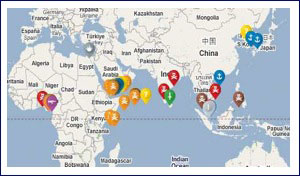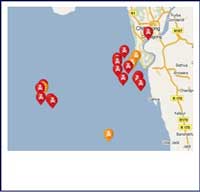
- A Guide to MaRisk: Risk Intelligence’s online threat monitoring solution, MaRisk, uses zoomable maps with multiple icons for more enhanced threat classification. Please refer to the reference chart for MaRisk icons in order to better utilize the accompanied maps.
The World Third “Hottest” Hotspot
Bangladesh is the third highest-ranking country for incidents in international piracy and insurgency statistics. Despite being tucked away at the bottom of the Bay of Bengal, Bangladesh and its primary port, Chittagong, remain a piracy hotspot. Even with a reduction in armed robberies two years ago, the five-year trend reveals that it is business as usual in Bangladesh.
The international community appears to have overlooked that piracy is only an umbrella term for a wide array of tactics and organizations. Piracy and its domestic cousin, armed robbery, come in many shapes and forms: The operating environment and coastal stability are key in determining what the most logical and realistic tactic will be for the greatest return in revenue for robbers and pirates.
Be it the highly profitable hijacking industry off the Horn of Africa, luring ships to bunker fuel illegally and then rob them in the Singapore Stairs, inside kidnap and ransom jobs in the Malacca Straits, to the highly successful robberies off the Anambas Islands, the concept of piracy should truly be regarded as an ‘umbrella’ term.
The international community and media also appear to be able to focus only on one form of piracy at a time. Prior to 2007, the focus was exclusively on the Malacca Strait. Since then, the shift in focus appears to solely be on the Horn of Africa. ‘Secondary’ high-risk zones, areas that the media neglect include the national waters of Peru, Malaysia, and Indonesia.
Therefore, the world’s third “hottest” hotspot Bangladesh, despite Bangladesh is a poor and volatile country and Chittagong port at a glance, seems like a hectic mess of chaos. Despite sinking within the mangroves as the rising sea levels and monsoons approach, Chittagong is one of the most important South Asian ports. The port area itself accommodates a population of 2.2 million inhabitants and in 2007, the medium sized port hosted 2,000 vessels carrying 28 million tons of cargo. Containerized cargo totaled nearly one million twenty-foot equivalents (TEUs). The Chittagong area is home to a large number of manufacturing and telecommunication companies that use the port city as their South Asian hub. Crime in Chittagong often entails activity within the port area ranging from armed robbery, cargo theft, smuggling, to fraud. Large-scale organized crime syndicates typically conduct these activities and have done so for many years. Kidnap and ransom has also increased, namely in the western mangroves of Bangladesh, where criminal groups are targeting fishermen.
Within the past year, there have been nineteen incidents occurring on vessels berthed or anchored in the Chittagong area. Although one robbery has occurred while berthed in the river, the bulk are occurring at anchorage, namely in the renowned Anchorage B. This location is vulnerable due to its isolation out in the bay and is particularly exposed due to poor law enforcement responses and the high concentration of small vessel traffic such as fishing boats, making it easier for the attackers to conceal themselves both before and after the incident. Approximately half of Chittagong incidents occur in Anchorage B, while the remainder have occurred at anchorages closer to the port.
In the failed incidents, the robbers aborted their attempts at the first sign of resistance, while in other cases, determined robbers in multiple boats and often armed, board the vessel and rob it by taking a crew member ‘hostage.’ This suggests that the groups operating around Chittagong port are diverse and range from sophisticated organized crime groups to more opportunistic fishermen. On 28 September, the bulk carrier D.D. VIGILANT was boarded at Anchorage B by eight suspects in a wooden fishing boat at night. The previous night in nearly the exact same location, the tanker KIRANA QUARTYA was boarded and robbed by the exact same number of suspects stealing ships stores. This suggests that there is syndication in some of the maritime robberies in the port area, however, their tactical level of violence and crew resistance threshold levels differ.
Armed robbery related violence spiked on 15 April 2006 when ‘Alauddin Bahini,’ the leader of the largest syndicate in Chittagong, was gunned down in a firefight in the outer anchorages. Since then the vacuum has been filled by smaller yet equally effective groups with respect to targeting ships. Currently the more violent forms of armed robbery in Bangladesh are occurring in the western waters and up in the Sundarbans. The robbers are known as Dacoits who live in small camps within the mangroves resembling the insurgency-like lifestyle of Niger Delta militants living within the bushes and creeks. Although reported incidents only include the targeting of fisherman, three different gangs reportedly kidnapped 72 for ransom on 14 September 2009. The primary holding area for kidnapped fishermen is the Kochikhal area, where fishing vessels have also reported being boarded and robbed. On 3 October, Bangladesh’s Rapid Action Battalion (RAB) claimed to have disrupted Dacoit operations in a counter piracy operation near Nil Dumur. The RAB apprehended the alleged leader, Amjad Hossain, and confiscated eight rifles and ammunition.
Incidents along the Bangali Rivier have increased where fishermen and a passenger vessel were reportedly involved. Earlier this year on 17 May, a fishing boat was attacked by heavily armed robbers and on 29 August, a passenger boat was attacked in the seasonal lake Goradigha Haor by approximately 17 armed robbers. A firefight with the marine police ensued before the robbers discarded their weapons and escaped by hiding in Boalia village. Fortunately the more violent attacks have yet to occur against shipping.

However, with 19 incidents occurring in the last year, Bangladesh remains a MaRisk hotspot and is the ideal example for armed robbery-style attacks against predominantly anchored vessels within national waters.
Prevention and Deterrence as Keys to Anti-piracy, if not Anti-robbery Policy
Vessels and their companies can prepare themselves to avoid being the target of an armed robbery in the Chittagong area. The proper implementation of anti-piracy measures can reduce the likelihood of a boarding, however, there are examples of vessels neglecting even the simplest measures and therefore succumbing to attacks.
One such vessel is the Panama flagged SERASIH managed by a Singapore company. The vessel was boarded and robbed on 22 September and again on 13 October. In both cases the vessel was robbed out at Anchorage B at nearly the same time of day (21:00-22:00 Local Time). In both cases the robbers easily boarded the vessel and captured a crewmember, threatening him with a knife and stealing ship’s stores before escaping. During the 22 September incident, the suspects were not detected until the very end of the robbery indicating that anti-piracy measures and crew readiness were poorly planned and ineffective. The subsequent robbery of the vessel exactly three weeks later indicates that little was learned and no additional security measures were implemented after the first incident.

Vessels calling on Chittagong and when at anchor particularly out in Anchorage B and A are to implement rigid anti-piracy measures. Incidents at both anchorages (B & A) occur at night and involved lightly armed suspects boarding the vessels from one to two boats. Increased lighting, doubled duty watches, and reinforced forecastle and ship’s store doors are all simple measures in preventing attacks. On 3 October, a bulk carrier successfully deterred an attack at Anchorage A with doubled deck patrols and by securing barbed wire on the sides of the ship.
Another example was the successful prevention of a robbery on the Pakistani flagged CHITRAL, a general cargo ship managed by the Pakistani National Shipping Company. The vessel’s crew managed to spot the suspects whilst attempting to board via the anchor chain and raised the alarm whereby the heavy and alert crew presence forced them to flee. Given that thus far the level of violence deployed against a foreign merchant ship has been low, implementing anti-piracy measures and learning from other incidents can help deter incidents in the future.
It is difficult to assess whether Bangladesh will subside or increase in piracy incidents within the next quarter. There appears to be no link with economic circumstances and the global recession. In the past, even when Chittagong port experienced one of its periodical strikes causing significant backlog, robberies did not intensify despite the increase in targets in the outer anchorages. Seasonal weather patterns have little effect on incident trends as well since there is seldom a concentration against merchant ships in a specific annual quarter. However, in the Sundarbans, the syndicates appear to be most active in correlation with the fishing season from August to March.
Armed robbery in Bangladesh has always succeeded due to the poor capabilities of the Bangladeshi maritime enforcement agencies and has generally flourished in both the syndicated and opportunistic realms. Although nineteen incidents in the Chittagong area are significantly high in proportion to other global risk areas, the level of violence within attacks on merchant ships has yet to escalate. It is possible that some of the syndicates operating out of the Sundarbans may relocate to the Chittagong area, however, it seems unlikely given the desire to specifically target local fishing boats and kidnap their crews.
Nevertheless, there are plenty of opportunistic robbers as well as better-organized syndicates operating in the Chittagong area, which will likely continue to warrant continued robberies in the port area. It may not be a dramatic hijacking, but Bangladesh does require due recognition because it is the global hot spot for armed robberies in national waters.
***
Karsten von Hoesslin is a Senior Analyst and Editor of Strategic Insights with Risk Intelligence and examines piracy, organized crime, and insurgency issues. He holds a Masters in Strategic Studies and is a PhD Candidate.
From Strategic Insights. No. 19 (October 2009), Published by Risk Intelligence, Vedbaek Stationsvej 18, 2950 Vedbaek, Denmark
(Tel: +45 70 26 62 30/ Fax: +45 70 26 62 40)
———-
***Posted January 3rd, 2010

